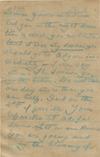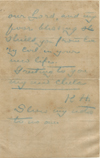Mahatma Letter to Leadbeater - LMW 1 No. 8
| Quick Facts | |
|---|---|
| People involved | |
| Written by: | Koot Hoomi |
| Received by: | Charles Webster Leadbeater |
| Sent via: | post |
| Dates | |
| Written on: | unknown |
| Received on: | 1 November 1884, early morning |
| Other dates: | unknown |
| Places | |
| Sent from: | Kensington post office |
| Received at: | London |
| Via: | unknown |
This letter is Letter No. 8 in Letters from the Masters of the Wisdom, First Series. Mahatma Koot Hoomi instructs Charles Webster Leadbeater to go to Adyar. It is closely related to the previous letter, No. 7.[1]
< Prev letter in LMW 1
Next letter in LMW 1 >
Envelope
|
[block print with no added notations] |
NOTES:
|
Page 1 transcription, image, and notes
|
Since your intuition led you in the right direction and made you understand that it was my desire you should go to Adyar immediately – I may say more. The sooner you go the better. Do not lose one day more than you can help. Sail on the 5th if possible. Join Upasika at Alexandria. Let no one know you are going and may the blessing |
NOTES:
|
Page 2
|
of our Lord, and my poor blessing shield you from every evil in your new life. Greeting to you my new chela.
Show my notes to no one. |
NOTES:
|
Context and background
Mr. Jinarajadasa provided these notes about this letter:
received on the night of the same day [October 31, 1884]
Transcribed from the original at Adyar. On receipt of Letter 7, C.W.L., who was living at Liphook, Hampshire, came up at once to London to see H.P.B., and intimated to her his decision to go at once to Adyar. At midnight of that same day this letter was received. In the first and second editions of this work I omitted the postscript, ‘Show my notes to no one’, as A.P. Sinnett, who was then living, had an idea that, with the exception of Miss Arundale, he was the only person in England who had ever received letters. Towards the end of 1884, he had created such a situation between himself and the Master (though he never realized it) that it was impossible for the Master to send further communications. Between Mr Sinnett and Mr Leadbeater there were cordial relations, and the latter owed much to Mr Sinnett, as he has testified, in beginning his Theosophical studies. Mr Sinnett was apt to doubt the genuineness of any letters received by others than himself. (See the postscript of Letter 19: ‘Prepare, however, to have the authenticity of the present denied in certain quarters.’ The proof of this doubt is in a letter, now at Adyar, which Mr Sinnett wrote at the time to Mr Leadbeater in which he doubts if the K.H. Letter to Colonel Olcott is genuine, or merely the precipitation of some chela.) Mr Sinnett would certainly have had something of a shock had he known that his protégé of less than two years’ membership in the Society had received communications direct from the Master. To the end of his life Mr Sinnett believed that he was in communication with the Master, first through certain sensitive women whom he could put into trance with passes, and later through a regular psychic medium whose body was taken possession of by so-called Masters. Mr Sinnett assured me that the possession was genuine and that one entity was the Master M. He never doubted these communications.
These two Letters 7 and 8 were not shown by C.W. Leadbeater to anybody except to myself [C. Jinarājadāsa], though I saw only the envelopes and did not venture to read them. In 1907, at Taormina, I copied them, and they were published in The Theosophist for the first time.[2]
See also the notes to the previous letter, No. 7.
Physical description of letter
According to Mr. Jinarajadasa, the original letter is at the Adyar headquarters of the Theosophical Society.
Publication history
Initially this letter was printed (with the Master's permission) in the January, 1908 issue of The Theosophist after C. Jinarajadasa copied it from the original during a visit to Taormina, as mentioned above.[3]
Letter 8 was published in 1919 as Letter 8 in the first edition of Letters from the Masters of the Wisdom, 1881-1888, later known as the First Series.[4] It has kept this designation as Letter 8 throughout all editions.
Commentary about this letter
C. Jinarājadāsa devoted an entire book, The "K. H." Letters to C. W. Leadbeater, to an intensive analysis of the three letters received by C. W. Leadbeater. At the beginning of the commentary for the first letter he wrote:
As this letter of the Master is full of illumination to students of Occultism, I propose, after the manner of the commentators of old of the Vedas and the Upanishads, to comment on all phrases in it which require elucidation, in order to bring out the full significance of the Master's thought.[5]
This second letter in particular provides a wealth of historical and occult information. Some details are provided in the Notes above. Here are some other major points:
- Intuition drove CWL's decision "to drop everything and leave at once."[6]
- K. H. knew that help was needed urgently at Adyar, both to help with the administrative burdens of Colonel Olcott and to shore up members who were wavering in the face of the Christian missionaries during the Coulomb crisis.[7]
- K. H., who had traveled in the West, knew the physical realities, schedules, and difficulties of travel by ship.[8]
- The legend of the Buddha, as related by Mr. Jinarājadāsa, helps to explain the letter's phrases related to blessings.[9]
- CWL was in some ways shielded from evil by the Mahatmas.[10]
- CWL was accepted as a chela, a process that ordinarily took far longer, because he had known Master K. H. in many previous lives and finally, in this incarnation, had the necessary leap of faith leading him to his Spiritual Path.[11]
- CWL was enjoined not to show the letters to anyone. This resulted from K. H.'s disappointment over the behavior of A. P. Sinnett.[12]
In discussing this letter, Jinarājadāsa goes further to relate a little-known sacrifice made by Leadbeater:
There was one sacrifice which Mr. Leadbeater made, to which he rarely alluded. Once when speaking to me of his coming out to India, he mentioned the incident, but quite casually, as if it were all a part of "the day's work." It was the sacrifice of all of a young man's plans of happiness in marriage to the girl of his dreams. For he was deeply in love with a girl, whom he had known many ears, the sister of his schoolboy chum. He had never let her know that he love her, first because he was quite shy, and thought himself quite unworthy of her; and secondly he did not wish to stand in her way in preferring someone else to him, for as he said to me: "A fellow can't ask a girl to marry him on £120 a year" – which was his salary as a curate. But he had strong hopes of preferment, and looked forward to the time soon when he could offer marriage to her...
When, however, Mr. Leadbeater read the Master's letter, even love itself was renounced instantly with all other things to follow him.[13]
Additional resources
Notes
- ↑ C. Jinarajadasa, Letters from the Masters of the Wisdom, First Series (Adyar, Chennai, India: Theosophical Publishing House, 2011), 32-33, 143-144.
- ↑ C. Jinarajadasa, 143-144.
- ↑ "Echoes from the Past" The Theosophist 29.4 (January, 1908), 358.
- ↑ Letters from the Masters of the Wisdom, 1881-1888. Adyar, Madras, India; London: Theosophical Publishing House, 1919. Foreword by Annie Besant; transcribed and compiled by C. Jinarajadasa.
- ↑ C. Jinarājadāsa, The "K. H." Letters to C. W. Leadbeater (Adyar, Madras, India: Theosophical Publishing House, 1941), 15.
- ↑ Jinarājadāsa, 56-58.
- ↑ Jinarājadāsa, 58-59.
- ↑ Jinarājadāsa, 60-61.
- ↑ Jinarājadāsa, 63-68.
- ↑ Jinarājadāsa, 68-70.
- ↑ Jinarājadāsa, 70-71.
- ↑ Jinarājadāsa, 71-73.
- ↑ Jinarājadāsa, 54-55


